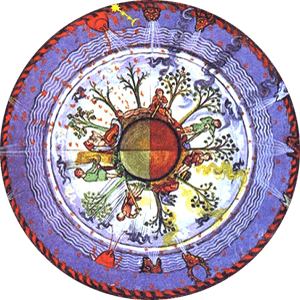
Blessed Hildegard von Bingen was a “Pre-Renaissance Woman” of the early 12th Century who wrote theological, botanical and medicinal volumes (including the use of herbs and gemstones), as well as letters, poems, and the first surviving morality play, while supervising brilliant illuminated manuscripts.
...This is a woman who became for men a guide, for the church a faithful critic, and for women a strong, strong model of what it means to be a full human being, a functioning adult, a person with a purpose in life...And, most of all, a prophetic model of a future church..." Click to read Sr. Joan Chittister's beautiful description...
One of her works, the Ordo Virtutum, is an early example of liturgical drama. In addition to her duties as Abbess of Rupertsberg, she was a prolific and highly original composer, whose music is still played today.
Although she called herself “but a simple womanly creature,” she was known to her contemporaries as the Sibyl of the Rhine.
As if these achievements were not outstanding enough, she soared above the boundaries of ordinary thought and knowledge, and into the sublime. Hildegard articulated a vision of God as a pulsating life-force present in our lives, interpreted as essentially feminine. Viriditas is a guiding theme, used constantly in her works. It has been translated in various ways, such as freshness, vitality, fertility, fecundity, fruitfulness, verdure, or growth. In Hildegard’s understanding, it is a metaphor for spiritual and physical health, which is visible in the divine word.
There is an abundance of literature written about Hildegard, ranging from scholarly to sublime; hagiographical to metaphysical; critical to spiritual...she has inspired creative works in nearly all disciplines. I’ll be making a few personal recommendations throughout the garden, and encourage visitors to make their own.

